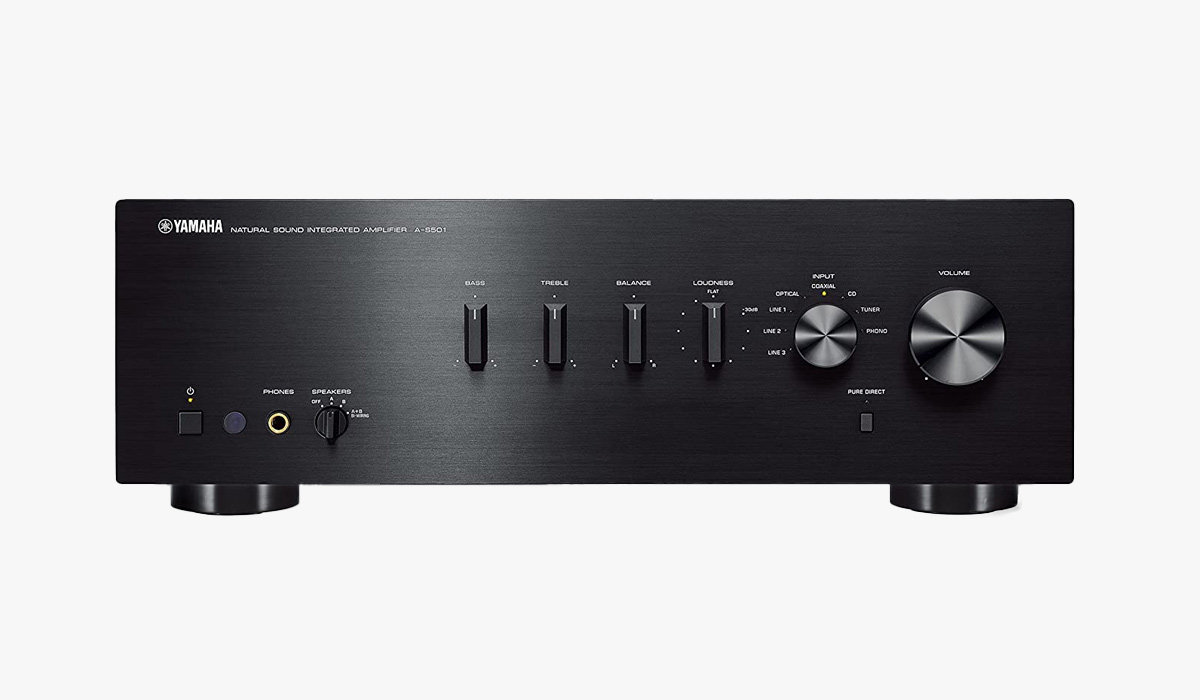Looking for a way to take your home-theater game to the next level? You need a stereo receiver. These handy devices act as a central hub for all your audio inputs, from streaming music on your phone, to the radio, to playing the most hipster-eque record off your restored vintage turntable. (Maybe a restored vinyl press of Nirvana’s Nevermind? We don’t know, you tell us.)
Receivers take those inputs, boost the signal, and send it to speakers–giving you control over EQ and other options along the way. Our roundup of the best stereo receivers on the market is here to help. We’ve got a little bit of everything, from the top stereo receivers on the market to some budget options. And we’ve even got some, eherm, sound advice to give you. So let’s take a look!
The Best Stereo Receiver
 Fosi Audio BT20A Bluetooth Stereo Receiver (BEST CHOICE)
Fosi Audio BT20A Bluetooth Stereo Receiver (BEST CHOICE)
Our Best Choice is the Fosi Audio BT20A Bluetooth 5.0 Mini Power amplifier. You can connect it to almost any Bluetooth enabled device via a QCC3003 chip for a strong connection up to 50 feet away. Texas Instruments components give you a powerful, crisp sound. According to Fosi, you get less than 0.04% harmonic distortion at high volumes.
If you’ve got separate passive speakers and pre-amps in your setup, this is the stereo amplifier receiver for you. The 100 watt per channel power output is strong enough to drive most consumer-grade passive speakers. An upgraded DC outlet and 24V/4.5A power supply deliver all the juice you need to rock out with your friends. On top of all that, the Fosi is an aesthetically pleasing compact stereo receiver, featuring rounded edges and elegantly simple controls.
For more top-quality audio devices, check out our guide to the best wireless speakers for TV.
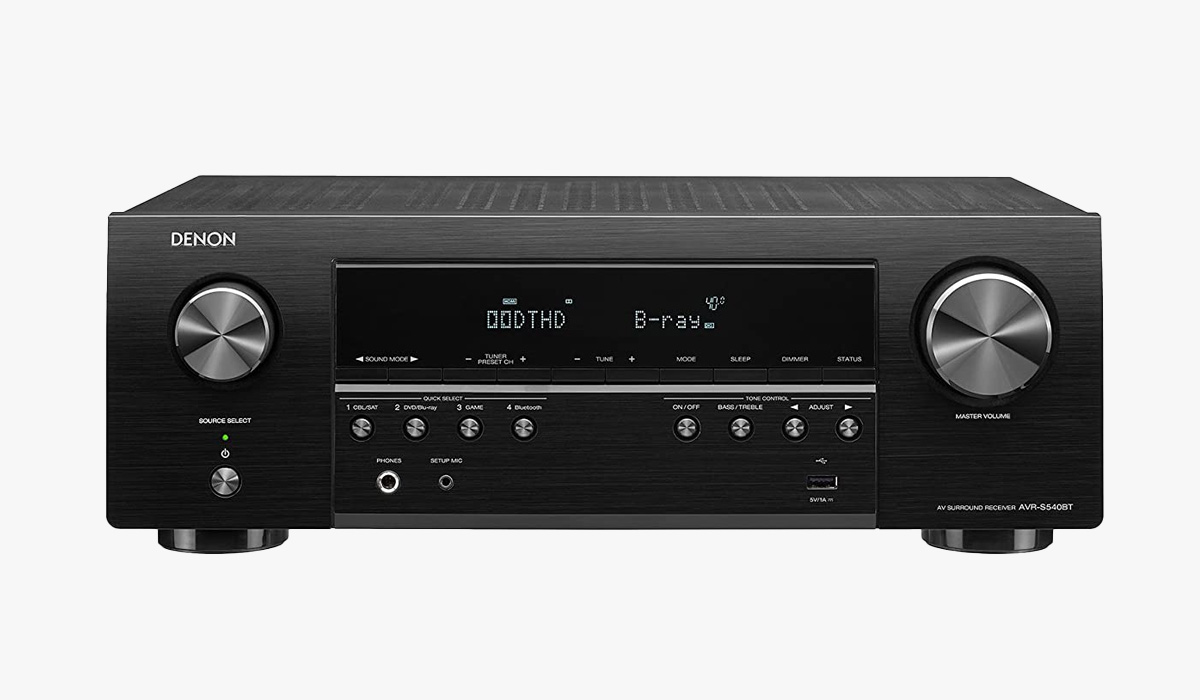 Denon AVR-S540BT Stereo Receiver
Denon AVR-S540BT Stereo Receiver
A powerful stereo receiver for the home theater aficionado. This offering by Denon features Bluetooth connections but also has a USB port. Even better, you can choose between 2.1, 3.1, and 5.2 channel surround sound, depending on your room size and audio setup. But why stop at vanilla surround sound? You can also access Dolby TrueHD and DTS HD Master Audio with this device.
It isn’t just about sound, though. That’s only half the experience. Tap into the visual wonderland that is HD video upscaling with 5 HDMI inputs with full-rate pass-through and HDCP 2.2 support. 4K Ultra HD, HDR, and Dolby Vision all enhance any at-home cinematic experience, turning a video snack into a full-on feast for the eyes. Finally, the Bluetooth feature lets you stream audio from all your favorite streaming services and turns your phone into a handy remote via an app.
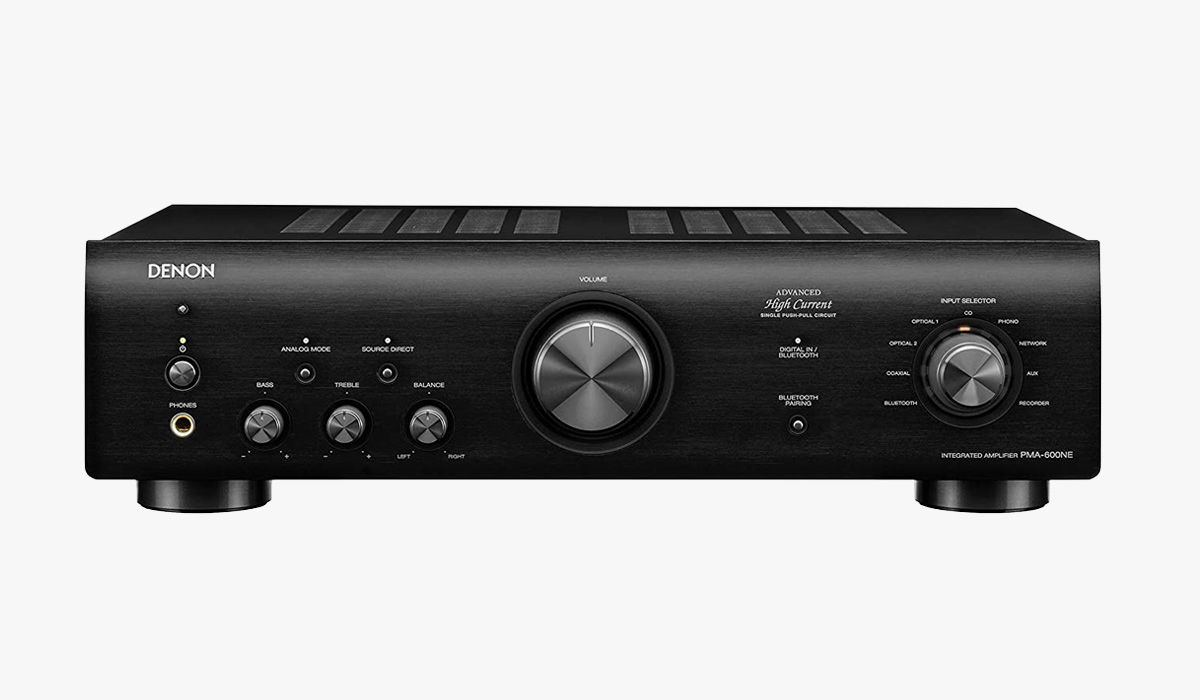 Denon PMA-600NE Stereo Receiver Integrated Amplifier
Denon PMA-600NE Stereo Receiver Integrated Amplifier
You might remember Denon as the maker of our “Best Choice” option. Here they are with another excellent product, albeit with one a slightly different function. This is a stereo receiver with phono inputs, so go ahead and plug in your old-school all-in-one turntables; we don’t mind! Analog lovers will love this high-end stereo receiver for its analog mode, which allows you to disable inputs and Bluetooth while listening to analog sources. No high-frequency interference for you!
Just because this stereo receiver has phono inputs and analog mode doesn’t mean Denon is forgetting about the home theater crowd. The 70W integrated amplifier delivers 70 watts of power per channel and works with a wide range of speaker types. The two optical inputs and one coaxial cable inputs support PCM signals up to 192kHz/25 bit. This is handy for anything from improving the sound quality of your Blu-ray disks to inputting from a high-quality source on your computer. As a final bonus, the PMA-600NE is Bluetooth enabled, so you can listen to anything you can play from your phone!
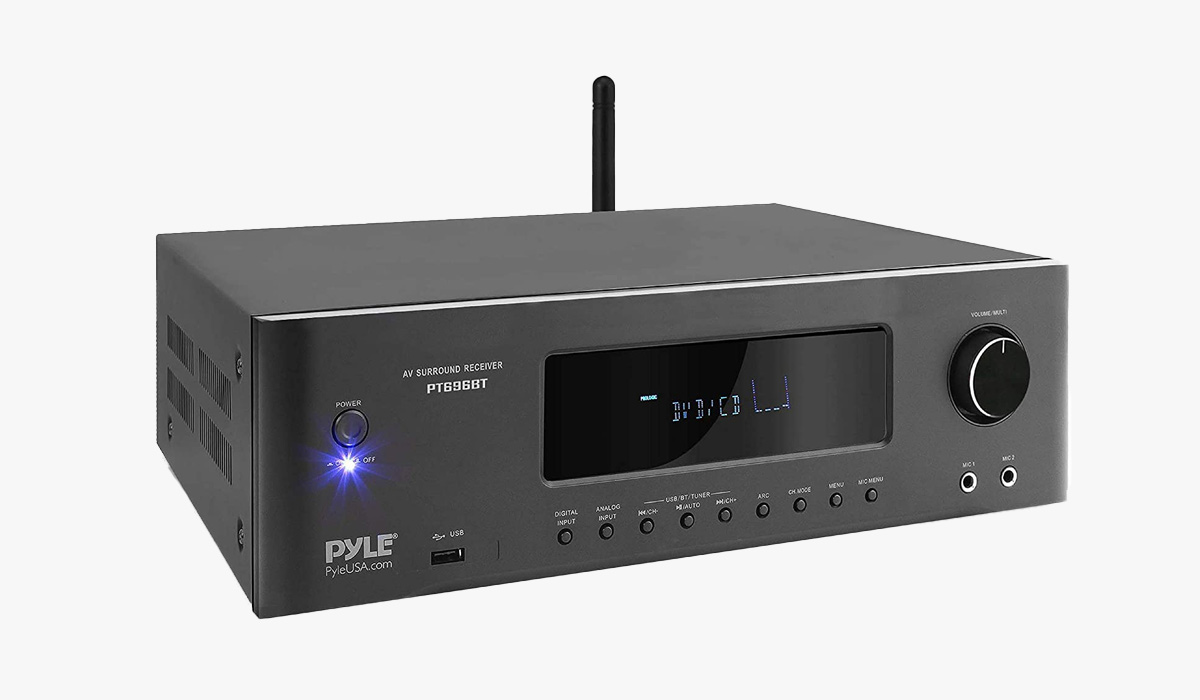 Pyle PT696BT Home Theater Stereo Receiver
Pyle PT696BT Home Theater Stereo Receiver
If you are a home theater geek but you are (like most of us) on a budget, have we got an option for you. The Pyle PT696BT is a Bluetooth home stereo receiver that features 5.2 channel surround sound, bass and treble adjustment, and a ported enclosure. The look is functional but sleek: Black, satin, and easy to slot into any pre-existing home entertainment system.
One thing we haven’t explored on this list yet is built-in AM/FM radio functions, and this stereo receiver has exactly that. When you combine that with its Bluetooth functionality, 1000-watt power rating, and EQ controls, you get quite a powerful and capable little system, and for a reasonable price too!
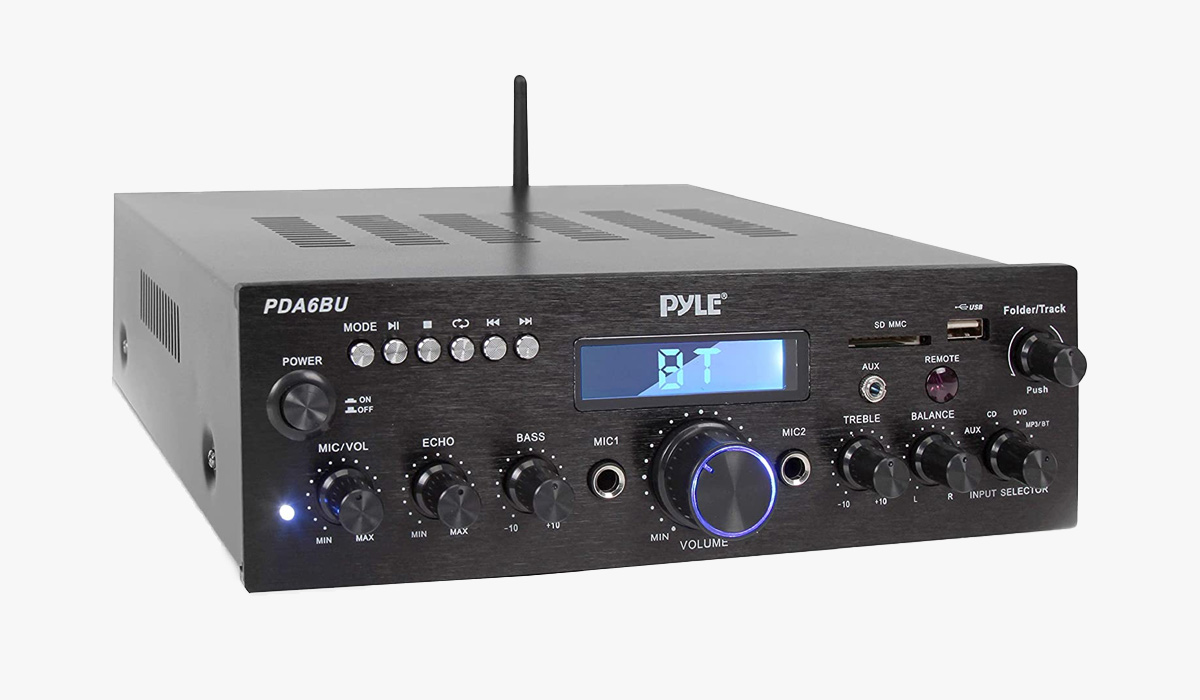 Pyle PDA6BU.5 Compact Bluetooth Stereo Amplifier
Pyle PDA6BU.5 Compact Bluetooth Stereo Amplifier
Got a karaoke itch but can’t scratch it because your favorite karaoke bar is closed due to Covid-19 restrictions? Sure! We all do! But luckily, this compact Bluetooth stereo amplifier is here to help you serenade your cats with “Hit Me Baby (One More Time)” at 3:15 in the morning.
This amplifier receiver is small but mighty, featuring built-in Bluetooth wireless streaming functionality, a built-in FM radio, 3.5mm input jacks, 1/4 inch microphone jacks, and RCA connectors. USB flash and SD memory card readers make this receiver super computer-friendly, and MPD digital audio file support will be a big help when the aforementioned karaoke night arrives. The USB port also doubles as a device charging location. An LCD screen helps you keep track of what song is playing through ID3 tag readouts and also gives you dialed-in access to all the controls you need to get your music just right.
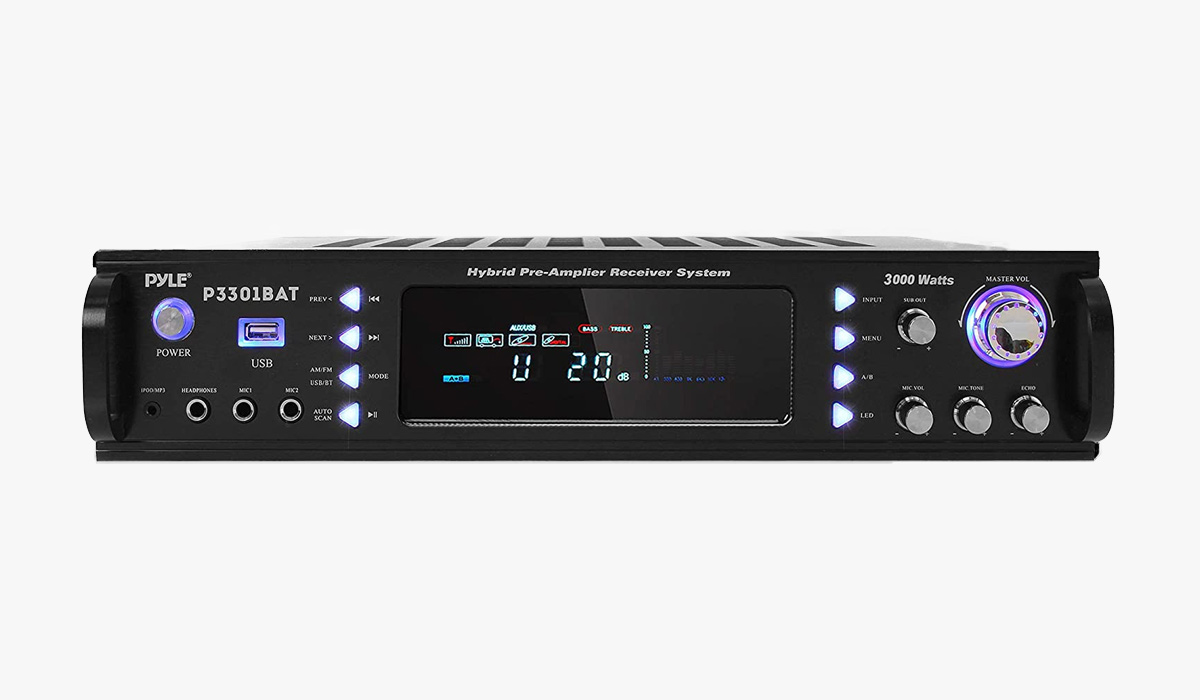 Pyle P3301BAT Wireless Bluetooth Home Stereo Amplifier
Pyle P3301BAT Wireless Bluetooth Home Stereo Amplifier
Can’t decide what speaker you want to blast your tunes from? Sure, sure, it’s a common problem. Well, we don’t know if it is or not, but just in case you are struggling with speaker indecision, the Pyle P3301BAT has you covered. The A/B/ speaker selector lets you choose from one or both of your speakers and also gives you control of volume, bass, treble, balance, and echo. And in case the other stereo receivers on our list weren’t powerful enough, this model boasts 3000 watts of power. What? Watt. You heard us.
You get five inputs with this multi-functional high-end stereo receiver–1/4 inch microphone, aux mp3, USB/SD in, and RCA. And in case you feel like scanning the radio waves to find that latest big hit, you have access to an AM/FM radio with 30 memory presents. Got a roommate? No problem. Dial in your settings with the LCD front control panel, and then listen to your jams via the headphone jack. No roommate or your roommate likes to jam? The antenna and included remote let you crank up the tunes without ever leaving the couch.
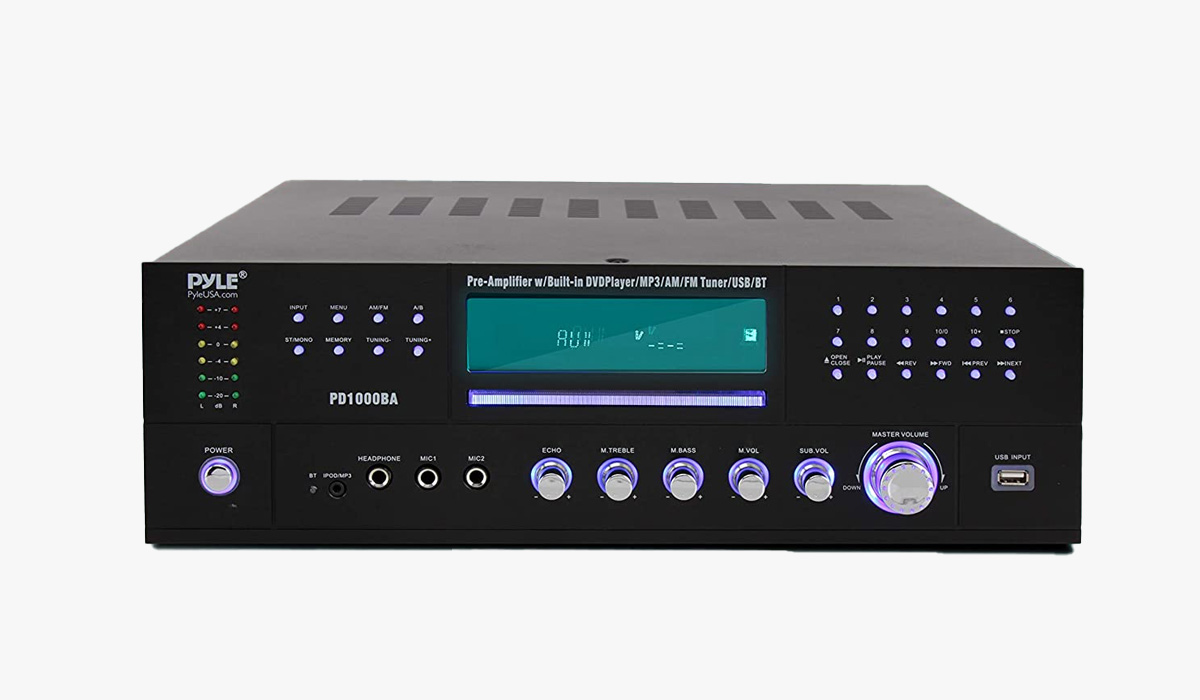 Pyle PD1000BA 4-Channel Wireless Bluetooth Power Amplifier
Pyle PD1000BA 4-Channel Wireless Bluetooth Power Amplifier
Another medium-priced stereo receiver packed with features, this PD1000BA model from Pyle stands out on account of its large display meter. The built-in fluorescent display helps you keep an eye on all the functions and inputs you are using. You can also rack mount this unit. When you combine those two functions together, you get a powerful system that might attract prosumer-level audiophiles.
This four-channel pre-amplifier also boats 1000 watts of power and is Bluetooth compatible. The front-loading DVD and CD player is also super-convenient! An AM/FM radio (with 50 station presets), USB and SD flash memory readers, 3.5 mm input, and two 1/4 inch mic inputs round out the feature set. We told you it was packed with features!
Pyle PT272AUBT Wireless Bluetooth Audio Power Amplifier
This compact stereo receiver is a little less powerful than some other options we’ve had on our list, comping in at 300 watts vs. the 700 or often, 1000, we’ve seen elsewhere. But that being said, it is still feature-rich, with Bluetooth 3.0, an AM/FM radio, two 1/4 inch microphone jacks, RCA input/output, and a banana binding post. It also supports USB and SD flash memory, as well as MP3 digital audio formats.
Rotary knobs for the EQ and a digital display put the controls right at your fingertips, and you can access some of the controls from an app on your smartphone. And at $89.95, the lack of power might be attractive to users who just need some basic functionality without the ability to blow out the hearing aids of their elderly neighbors.
Yamaha A-S501BL Stereo Amplifier
This Yamaha A-S501BL is a stereo receiver for the most discerning of the discerning. It has gold-plated speaker terminals and RCA terminals for absolutely clear, interference-free sound. The custom-made power transfer features aluminum heat sinks, and the base contains anti-resonance technology.
Continuously variable loudness control adapts to your tunes in all their powerful moments and quiet interludes. Toss in a remote for good measure, and you’ve got a quality machine. At $550, this stereo receiver is not for the dilettante, and it lacks some of the features (like an LCD screen) that our other options include. But what it lacks in flash, it makes up for in sheer sound quality.
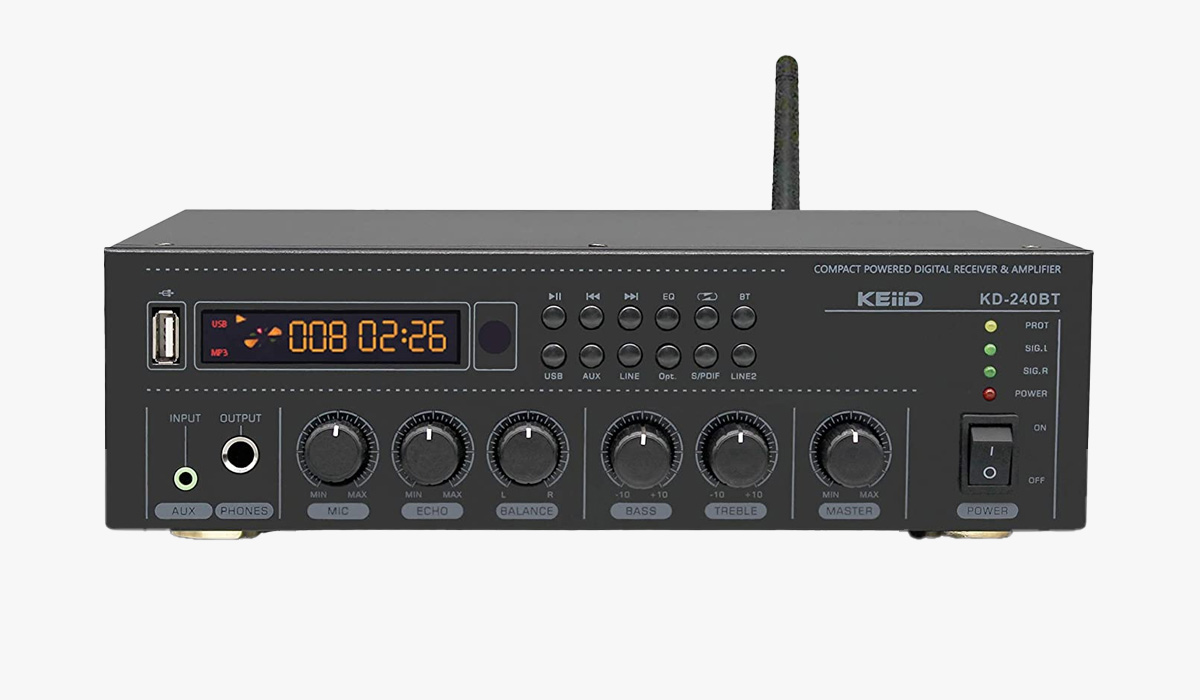 KEiiD KD-240BT Bluetooth Digital Amplifier Receiver
KEiiD KD-240BT Bluetooth Digital Amplifier Receiver
We’ll wrap up our guide with a multi-functional stereo receiver with the very latest in Bluetooth technology (Bluetooth 5.0). This receiver has a few of the features you’ll be expecting from items on our list by now: adjustable EQ options, remote control, and USB and aux inputs. But it also packs in a few features that are unique on our list, such as a 6.35 mm headphone jack and pager mode for letting your voice be heard over other inputs–perfect for DJing and hosting!
The Bluetooth 5.0 lets you connect at 65 feet or less, and the 3.5 mm subwoofer audio output connects to an active subwoofer and really does make it all about that bass, bout that bass (no treble.)
Stereo Receiver Buying Guide and FAQ
Features to Look for in Stereo Receivers
Power – If you like things loud, you want power in your amplifier. The more power (measured in watts) an amplifier has per channel, the louder the signal will be. It’s important to note that doubling the watts per channel will only increase the sound level by 3 db (it takes 10 db to be about twice as loud).
Remote Control – Hey. Put down your phone. Get up. Move around. Stretch a little. Your couch potato lifestyle is slowly killing you.
That done, one of the features you should look for in a stereo receiver is a remote control. It’s pretty self-explanatory–a remote lets you control various settings of your receiver without getting up off your cozy, murderous sofa.
A few of the devices in our Buyer’s Guide feature apps and Bluetooth connectivity that allow you to turn your smartphone into a remote control.
Radio Tuner – Is radio dead? Well, not if you have a great classic rock or blues radio station that churns out killer tracks on a regular basis. A built-in radio and tuner is a bonus when dealing with stereo receivers because you don’t have to take precious horizontal storage space in your house with yet another device. Look for models that include
Phono Inputs – This is a special type of input usually only found on vintage stereo receivers. Phono inputs are specially designed to boost the otherwise soft signal from phonographs or turntables. If you’ve got a lot of analog devices in your audio set-up, look for a stereo receiver with phono inputs. They look like RCA inputs, but they aren’t the same!
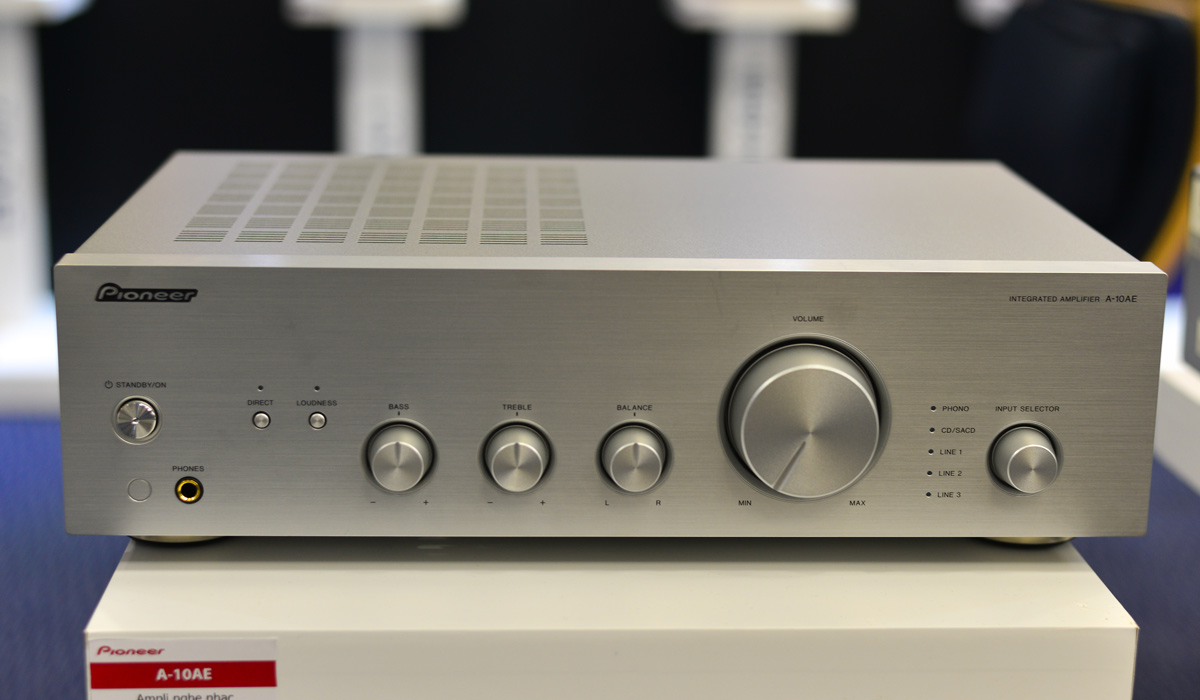
Digital Inputs – Digital inputs like 3.5 mm aux, SD, or USB flash are handy for playing music from devices or importing audio signals from your computer.
USB – See our above answer about digital inputs. Something else to keep in mind about stereo receivers is that not all of them support MP3 formats (such as you might find on a USB drive). Look for stereo receivers that promote this function if you plan on doing a lot of digital listening.
Bluetooth – Bluetooth enables your stereo receiver to connect to all manner of devices, allowing you to play an almost unlimited variety of music from your phone, tablet, computer, and so on. Almost all the devices in our Guide are Bluetooth enabled, but not all of them are running the most recent version of Bluetooth. The newer, the better…
Headphone Output – If you have roommates, are in a relationship, live in an apartment, or just have neighbors living in close proximity, there are times that you just shouldn’t blast your music or movies. That’s what headphone jacks are for! Look for this feature in more high-end models.
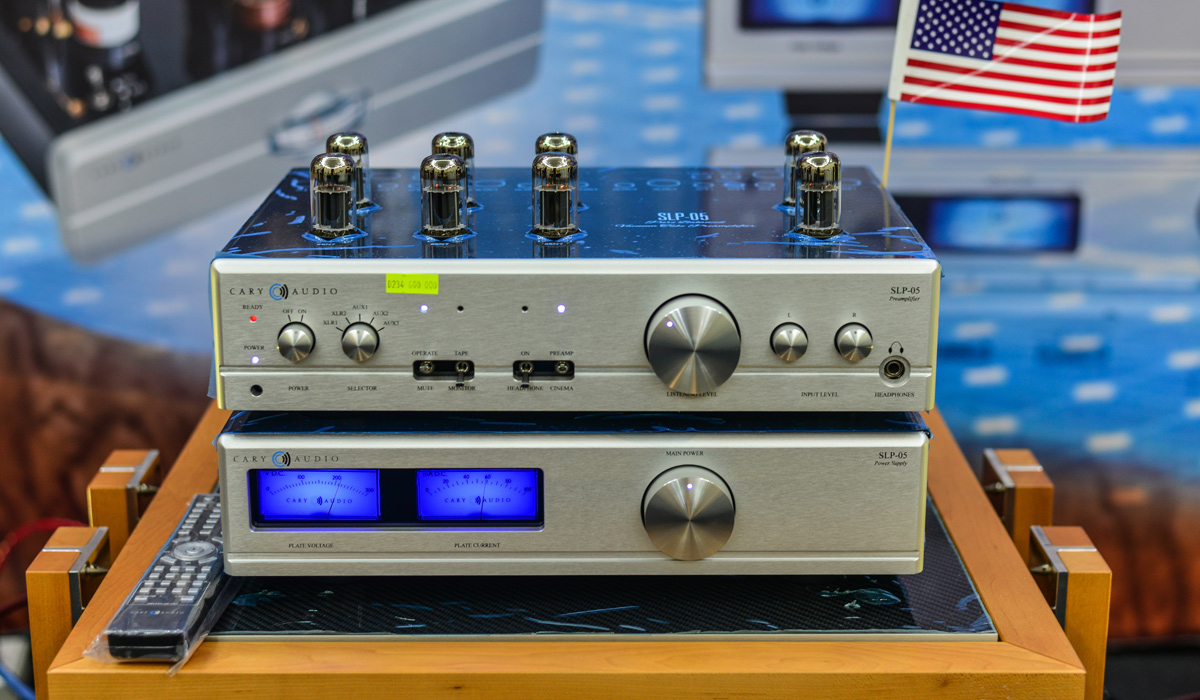
Stereo Receiver FAQ
What are stereo receivers used for?
A stereo receiver takes audio from a source (like your phone, a Blue-ray, or a turntable), amplifies it, and sends it to your speakers.
Do you need a stereo receiver?
If all you want to do is stream music off your phone, you don’t need a stereo receiver. If you want to boost audio signals from a variety of sources, dial in your premium surround-sound experience, and have maximum control over sound quality, you need a stereo receiver. Receivers often have multiple inputs and act as a hub for all your audio sources, helping you control and get the best sound quality from each.
What is the difference between a stereo receiver and amplifier?
The difference between an amplifier and a stereo receiver is slight but important to note. An amplifier takes low voltage signals and amplifies them into a signal that can be used by your speakers.
A receiver does the same thing but also includes a built-in radio. That’s what the “receiver” in “stereo receiver” means. It’s “receiving” radio signals. So, technically, some of the devices on this list are simply amplifiers, as they lack radio functionality. But the term is used somewhat interchangeably.
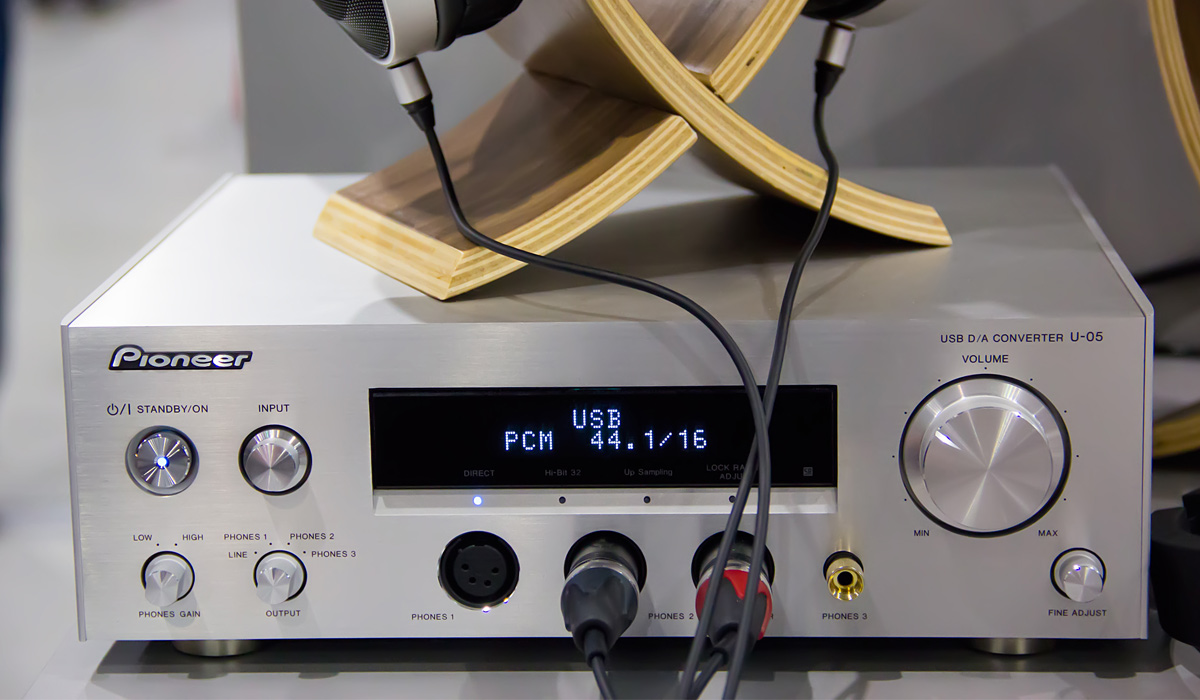
Do vintage stereo receivers sound better?
This is hard to quantify, but we’ve found some blogs that seem to indicate this is the case. According to a few sources, manufacturers these days are more focused on making features work (such as Bluetooth and Surround Sound) than designing for superior sound quality. On top of that, many people don’t listen to receivers before they buy them, as opposed to the days when you could walk into a specialty audio shop and fully experience a piece of equipment before you bought it.
That all being said, we suspect that only a few million people in the world can truly tell the difference. Chances are you aren’t one of them, so we think buying a modern receiver is totally fine.
Should I leave my stereo receiver on all the time?
Are you running a professional recording studio? We’d guess not, since you are reading this article. In that case, go ahead and turn your receiver off. There’s no sense in leaving it on–the idea you had to is based on older technology. Leaving it on will draw power and create heat, though not much of either if it has a standby mode.





